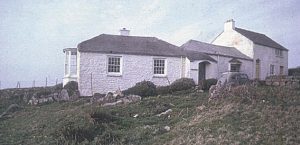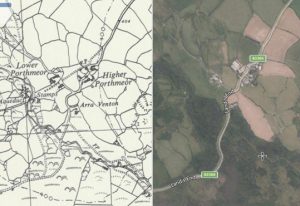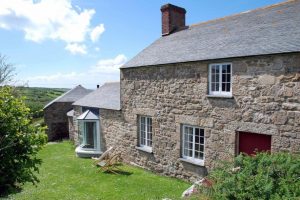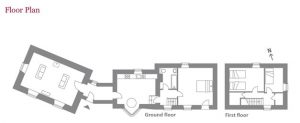
Higher Porthmeor is a small settlement on the B3306 between Treen and Morvah in the parish of Zennor. In the past it was an important area for mining and farming. Nowadays, many climbers meet to climb Bosigran cliff, commonly known as Commando Ridge, which is where cliff climbing training took place in WW2. Porthmeor Cove is a large, sheltered cove among towering cliffs and is so named as Porthmeor means Great Cove. There have been many ships wrecked in this area. There is a lot of interest in Porthmeor as archaeologists have unearthed the remains of ancient iron age settlements in the area. One local headland is named ‘Trereen Dinas’, which means ‘Cliff Castle’ and another ‘Bosigran Castle’, which is the site of an old fortification. The Porthmeor settlement was previously discovered but unearthed in 1933 by Frederick Christian Hirst (1874-1938). He had previously been working on nearby Chysauster. This profile of its Wesleyan chapel was compiled by Val Thomas.
 Porthmeor Old Chapel which is now a dwelling called ‘Arra Venton’. (Photo: David Allan collection courtesy St Ives Museum)
Porthmeor Old Chapel which is now a dwelling called ‘Arra Venton’. (Photo: David Allan collection courtesy St Ives Museum)
1839: Porthmeor Wesleyan was founded with seats for 120. (West Penwith Resources – Chapels)
1851: William Burgess completed the return.
1873: The survey reported 100 seats.
1900: New stamps for tin production were installed on Porthmeor stream. It was a busy area with men from Nancledra and Towednack using the two huts already erected.
1903 February: The chapel is being renovated. “Tenders are invited for the renovation of Porthmeor Wesleyan Chapel, Zennor. Apply for particulars to Messrs William Thomas, T H Eddy or W Berryman. Tenders should be sent in by Saturday 28th inst.” (The Cornishman 26th February 1903)
1905: “The Wesleyans (Porthmeor Chapel) held their anniversary tea on Saturday, Towednack Band being in attendance. Mr W Berryman, of Porthmeor, kindly lent a field for the occasion. There were a good many present. The tables were presided over by the Misses Thomas (4), Roberts (2), Ann Eddy and Bessie Berryman. A short service in the chapel brought a most enjoyable day to a close.” (The Cornishman 22nd June 1905)
1907: An inquest into the suicide of Mrs Arthur Berryman of Porthmeor Farm took place in the old Wesleyan chapel. Arthur himself died by 1941. “Suicide at Gurnard’s Head. Husband’s painful discovery. Mrs Arthur Berryman, wife of Mr Arthur Berryman, of Porthmeor Farm, Gurnard’s Head, committed suicide on Monday of last week by cutting her throat. No reason can be assigned for this rash act, and great sympathy is felt for Mr Berryman in this sad calamity.” (The Cornishman 2nd May 1907)
1908: The Cornishman of June 18th reported that the Porthmeor Sunday School tea was held on Saturday. The Towednack brass band was in attendance and played a large number of selections during the afternoon and evening. The Sunday anniversary services drew large congregations.
It was reported in The Cornishman newspaper of 30th July: “The children attending Porthmeor and Churchtown Wesleyan Sunday Schools, accompanied by their teachers, parents and friends had their outing to Carbis Bay on Saturday”.
1906-1908: The map, surveyed in 1906, shows that the road towards Morvah was unmade at this time and the chapel sits very much on its own beside a series of footpaths. It is still tucked away today.
1908: The Cornishman of Thursday October the 8th says: “The harvest festival in connection with the Wesleyan Chapel was held at Porthmeor on Saturday and Sunday. On Saturday a public tea was provided, and it was well patronised. After tea the Zennor Churchtown choir rendered the service of a song entitled ‘The Golden Hill’ the connective readings being given by the Rev. F. J. Mann, circuit minister. Large congregations attended the thanksgiving services on Sunday afternoon and evening, the services being conducted by Mr Spear. The chapel had been prettily decorated with corn, fruit and flowers.”
1923: The Cornishman and Cornish Telegraph newspaper of Wednesday July 4th reported: “On Saturday the Porthmeor Sunday School tea and services were held at Zennor. The procession of Sunday School scholars and friends was headed by the Towednack Band, which also gave selected music outside the church to the pleasure of all present. In the meantime the children received their buns, and a public tea followed at 5pm, which was well patronised… thanks are due to Mr. M. Osborne, who is superintendent of the Sunday-school.”
1923: The Chapel was still in use for services. The harvest festival was spread over two days. (Cornishman 26th September 1923)
1933: The first annual general meeting of ‘The Cornwall Excavations Committee’ was held and Frederick Christian Hirst was offered and he accepted the post of President and Director. The meeting was held in the old chapel at Higher Porthmeor, not far from the iron age settlement. His collection of everyday objects led to the formation of The Wayside Museum in Zennor which has now closed. Items from this collection have now been distributed between other museums including the St Ives Museum.
1936: An article directing visitors going to see the excavations were told to “…alight at the Porthmeor old chapel, whence a footpath leads to the site”. 190 Old Cornwall members visited in March of that year.
 This map of Zennor was found in West Penwith Resources – Rick Parsons 1999
This map of Zennor was found in West Penwith Resources – Rick Parsons 1999
1979: We had friends who lived in the Chapel as their home. The front door was on the side facing the parking area and to get to it you passed a very large, curved glass window which was set into a wooden frame. The house was linear and there were steps inside. On entry you turned to the left into the dining room with the curved glass window. You then stepped down a level into the room facing the road which had a vaulted ceiling and was quite large. It had a wooden floor and a very large window which reminded me of the type of window which was on the back of wooden boats in earlier times.
 2021: The chapel now appears to be called ‘Arra Venton’, probably due to the well which is next to it.
2021: The chapel now appears to be called ‘Arra Venton’, probably due to the well which is next to it.
 The Converted Chapel in 2020
The Converted Chapel in 2020

Resources:
Standing Stones of the Land’s End Peninsula, A study of menhirs of West Penwith, Cornwall – Ian McNeil Cooke
West Cornwall Resources – Chapels
Find my Past internet research
The St Ives Museum
Map of St Ives area – West Penwith Resources – Rick Parsons 1999
National maps of Scotland
